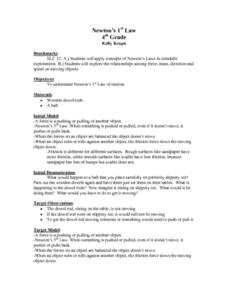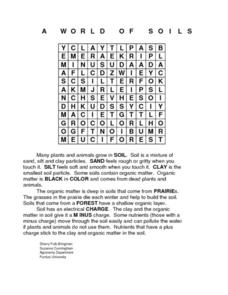Curated OER
Wiggle Worms
First graders investigate worms, collect and analyze data. In this worm and data lesson, 1st graders listen to Chick and Duckling from the Macmillan/McGraw-Hill reading series. They conduct experiments with worms, collect simple data,...
Curated OER
Touch
Students discover how sense of touch helps us explore our world by feeling it and learning the size, texture and shape of things.
Curated OER
It Matters
Learners use descriptive vocabulary to discuss the attributes of matter. Then, they sort objects or pictures by the type of matter they are comprised of. Finally, students match objects of matter with similar attributes and create a...
Curated OER
Cell 3: Organelles B
Students, after researching cells, construct a model cell. They explain the structure and function of eukaryotic organelles in a presentation. In addition, they create their own analogies to describe the structure and function of...
Curated OER
Matter for Minors
Students use streaming videos, web sites, and hands on activities students to explore matter. They focus on how temperature affects matter and what the particles look like in the states of matter.
Curated OER
Freddie Feels
Students become aware of the sense of touch and the body parts effected by touching. In this five senses lesson, students touch mystery items and create a touch page. Students discuss the body parts connected to the sense of...
Curated OER
Guess Who? Coral
Fourth graders identify and group coral formations. In this coral identification lesson, 4th graders examine coral pictures, discuss vocabulary, and provide similarities and differences in the growth formations.
Curated OER
Lesson Plan Seven: Sensorama
Students identify five senses, and use their senses of touch, sight, hearing, smell, and taste to distinguish different objects, sounds, smells and tastes, and write their answers in the booklet.
Curated OER
The Great Rock Sort
Students describe and sort rocks according to their physical properties. They listen to a story and discuss what they know about rocks, then work with a partner to discuss how their sample rocks differ from each other.
Curated OER
Newton's Ist Law
Fourth graders explore Newton's First Law of Motion. They conduct an experiment to observe what happens to a ball that is placed carefully on slippery ice. They also observe what happens to a dowel on the ice, then draw and label...
Curated OER
Newton's 2nd Law
Fourth graders explore Newton's second law of motion, testing and identifying the characteristics of objects that makes them easier or harder to push. They identify what types of objects are the hardest to move, then test a variety of...
Curated OER
What State Are You?
Students identify three states of matter and recognize plasma as fourth state. They provide examples of matter that are classified in particular state and identify properties of each state of matter.
Curated OER
Seed Sorting
Students examine and sort seeds. In this life science lesson, students make general observations of a tub of seeds, then develop sorting criteria for sorting the deeds. Lesson includes extension activities.
Curated OER
Sense of Touch
Students identify their five senses by reading a story. In this human anatomy lesson, students read the book, Here Are My Hands by Bill Martin Jr, and touch a variety of objects. Students describe and record each object they...
Curated OER
Kaleidoscope
Students explore energy by creating a light project in class. In this kaleidoscope lesson, students discuss the properties of light and how mirrors can reflect the energy in different directions. Students view a diagram of light...
Curated OER
Six of One, Half Dozen of the Other
Students explore the garden with all five senses. In this Science lesson, students collect specimens from the garden to classify. Students use adjectives to describe the objects collected.
Curated OER
A World of Soils
In this word search worksheet, young scholars read several paragraphs about the types of soil. Students then use the bold words to complete the word search puzzle.
Curated OER
Can You Tell By Touch?
Students feel inside a bag and use only their sense of touch to describe and identify one of the objects that is inside the bag.
TutorVista.com
Cell Labeling Worksheet
Here is a basic fill-in-the-blank resource with a short introduction to cell structure and organelle vocabulary. Information and worksheet are not separated, so it may be helpful to copy and paste the questions into your own document.
Curated OER
What's the Texture?
Students sort, classify, and write about how they sort a variety of shells.
Curated OER
Resistance is Futile
Students participate in two hands-on demonstrations to explore how friction can make objects hard to push.
Curated OER
Reflection & Refraction
In this online interactive reflection and refraction worksheet, students respond to 7 multiple choice and fill in the blank questions regarding the information included in the provided paragraphs.
Curated OER
Oobleck
First graders explore Oobleck. They manipulate and observe the properties of Oobleck. Students discuss the differences between solids and liquids. They investigate Oobleck. Students write a sentence describing what they observed about...
Curated OER
Eukaryotic Animal Cell, Candy Cell Model: Science
Learners review the parts of the eukaryotic animal cell and construct a model using various types of candy.























